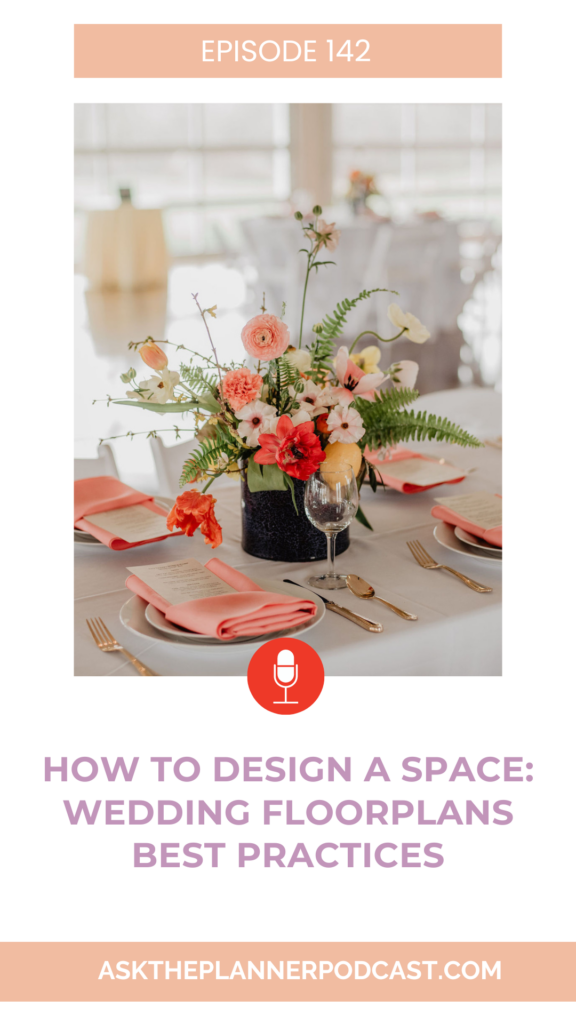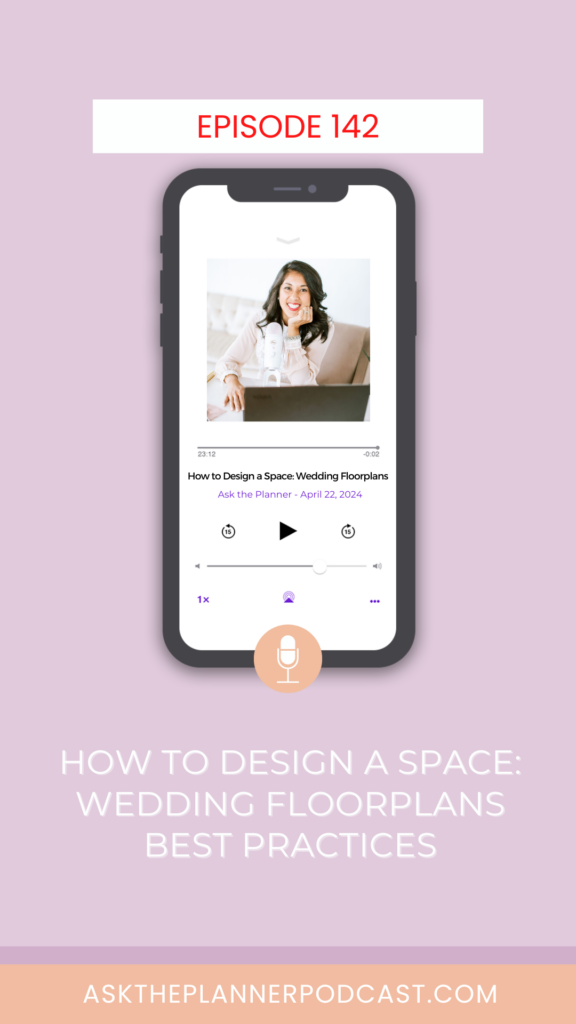On today’s episode, we’re breaking down everything you need to design a functional and beautiful space. This episode is for my couples, planners and venue owners that are listening because we go deep on the floorplan creation process. Before you skip this episode because you think you know everything about making a floorplan or you don’t need one because your venue already sent you some examples and you’re just going to use those, think again. We have a special guest today talking with me about important things you’re forgetting to include in your wedding floorplans and we also reveal common mistakes people make when it comes to designing their floorplans.
Also, make sure you listen to the end of the episode where I show a special discount for our listeners. Loverves, you’re going to love today’s episode, so let’s get to it.
NOT READY TO START PLANNING? SAVE THIS POST SO YOU CAN COME BACK TO IT LATER!

LISTEN & SUBSCRIBE ON YOUR FAVORITE PLATFORM
(SEARCH FOR EPISODE 142)
Apple Podcasts | Stitcher | Spotify | iHeartRadio
You can also listen on your Alexa-enabled device. Just ask “Alexa, play the Ask the Planner podcast.”
Meet Randi Bushell: Founder of Merri
RANDI BUSHELL IS THE FOUNDER & CEO OF MERRI, a collaborative planning software bridging the gap between event professionals through immersive 3D technology, hands-on design tools, and integrated workflows. Randi founded Merri as the missing solution she needed when planning her wedding in 2018. Named an industry disruptor by Authority Magazine, her commitment to innovation has led Merri to become one of the fastest-growing platforms in the event industry. Randi was also recently listed in Eventex’s 100 Most Influential People in the Event Industry.
Can you tell us about the actual inspiration behind creating Merri?
There was one night about three months before the wedding and we were trying to make final decisions on the day-of stationery. We were ordering off Minted, and there’s so many options. It was so overwhelming because I am a visual person, and found it hard to visualize if the menu we were looking at would match the types of linens we selected. So I Googled gray velvet linen and took a swatch, then grabbed three different images from Minted, and found floral inspiration off Pinterest and made a “3D rendering” of all of those in a PowerPoint slide. That was the moment I started to wonder, why nobody has built a drag and drop, user-friendly program like this where it tells you how much it costs, where can you get it from and seeing it in the context of your venue.
When you had that moment, did you decide to make the software? Did you do research? What was that like?
I am a very risk averse person, I like comfort. I never saw myself as an entrepreneurial person for that reason. So I sat on it for a while. I just kept thinking about it and talked to other people about it and everyone thought I should do it. The idea started around October 2018 and in December I reached out to my now co-founder. We started doing it part-time but when I got back from my honeymoon in February, I knew that was when I needed to start doing it full time. I was panicking, but the six month period I had of dipping my toes in gave me time to do a ton of research. I talked to a bunch of event planners, because I didn’t come from this industry, all I knew was my personal experience as a bride. But there was so much more to learn.
When you were researching, what did you find was lacking in technology or software?
The three core customers we work with today are venues, event planners and designers and rental companies. When we first launched, we wanted to first focus on venues. We wanted to help venues better showcase their space and ultimately help their clients through the planning process. What I learned was the venues didn’t care about the difference between a 2D floor plan and a 3D rendering. They will me that the planners are going to care more about that. So, a few months into it we changed our focus to the planners. Then the planners can bring those other market constituents along for the ride.
What would you say to a planner or couple about how important a floor plan is into the overall wedding planning and design process?
You would never build a house without an architectural diagram. That is a good corollary because when you're building a house, you have the architect, the general contractor, an interior designer (if you’re using one). This is similar to planning an event where you have all these different cooks in the kitchen. The floor plan dictates how much of everything you need to order or what the venue provides. It dictates a lot of the budget, how the overall event is going to flow. What space can you use for what part of the event based on guest count, decor, lighting, draping, tenting, things like that. It's not just about throwing tables and chairs into a diagram. It's meant to be your entire design decisions that play a role in how the event is going to get set up and what it's going to look like.
What are some challenges that you’ve seen planners face when designing their floor plans? And how have you addressed it, or changed the platform because of it?
When you start a software company, your work is never done. Every feature is a series of meetings where we document and talk about how it’s going to work. And without fail, you have to make trade-offs for time because an engineer is going to say they can build something in say three weeks, or if we cut these five things it’ll take me three days. Then we can move on to other things we want to build. We are having these conversations every single day.
To be honest, we prioritize our roadmap a lot on feedback we get from planners, venues and rental companies. We try to understand what they’re struggling with. I had someone tell me they love the 3D but sometimes they just need to make a quick diagram. So now we offer both 2D and 3D modes.
We believe 3D design is the future. Merri has the same technology as a video game, so it’s pretty heavy for your computer to run it. So we are constantly tinkering with different settings so that someone’s older computer doesn’t struggle with the real time rendering. We want the rendering to look photorealistic and we want it to run fast. We’ve done a lot of work on that so hopefully people notice our loading time is much faster now.
What are some key elements and tips you have for planners and couples putting together their floor plans?
I still think starting with inspiration makes sense. I know I just mentioned that the floor plan is the blueprint, but there's a precursor to that. Which we actually have a big product release coming out next month. It involves inspiration and it involves AI. I think that that orients you around what do I want? Then you bring that over to Merri and we have a catalog of 83,000 items to choose from between chairs, tables, linens, chandeliers, escort cards, you name it, we’ve got it. Merri lets you pick individual elements and options that you want, and then gives you the total price of it. So you might need to swap certain things in or out.
Once you’ve aligned on ideas, bringing it into Merri to see different options is the best way I see people using it. There’s more than one layout option and you can use Merri collaboratively to make decisions together by inviting a collaborator and you can see each other’s work. This is where I see people being most successful.
What do you think are the biggest mistakes couples or planners make when designing their floor plan?
I think people wait too long to do it within the process of planning a wedding. I am shocked when I look at the data and take the event date versus the floor plan creation date on Merri, how many people are creating the floor plan a month or two out. Maybe they are doing more coordination and pulling it all in at the last minute, so that is fair, but that’s one thing I wish more people would pull back farther in the process because it’s such an iterative process and it’s a grounding mechanism for everyone to work towards. It will change a hundred different times, but at least you have it as a starting point. There’s budget decisions that go into planning a floor plan, if you’re not allocating enough money in the budget earlier on then it’s not going to be there towards the end.
Can you discuss the importance of accessibility when designing a floor plan? Especially if you have guests with mobility issues.
One of the things we implemented was what we call “rules”. So, if a venue has a requirement that table need to be this a certain distance apart, on Merri, if you break that rule, your tables will turn red and it will tell you the tables are too close. We have a few tools that allow you to control where you can select a row or a grouping of tables and align them by X amount of feet. We also have a ruler tool, so if you had this off to someone else to set it up day-of, instead of eyeballing it, the ruler tells the person setting up how far away everything is from each other.
Can you explain the process and design tools to help people understand what they would be able to use Merri for?
As mentioned before, we have this big catalog of items. Once you go into the 3D design application, we’ve built a set of tools that allow you to use the items in the way you need to use them for an event. For example, we have a tables tool, and within the tables tool you can apply linen, napkins, chargers, plates, champagne flutes, water glasses, wine glasses. You can put your centerpiece with floral or candle accents around it. We have different categories you can toggle on and off.
Similarly, we have a tent tool where you can choose to customize your tent with sidewalls, doors, ceiling draping, flooring. So different types of subparts of an overall concept to your design. We have everything from staging, adding facades, skirting, railings and stairs, dance floors, chandeliers, hanging lights, uplighting and other environment lighting.
If my venue is not in Merri, how will I be able to use Merri?
We have a catalogue of thousands of venues already, if we don’t have the venue, we have a build it yourself and a we build it for you option. Starting with we build it for you, there’s a form you fill out on the website. As long as you can upload a floor plan with either a scale or measurements on it with some reference photos, (because we can't make a 3D model off of just a floor plan), we will create it for you. This is a free service we offer planners as part of their subscription. Ultimately, that goes into our catalog, then over time there’s more and move venues to use.
Then, the build it yourself tool, this is also a data point that surprises me over 40% of planners build their own venues. I would've thought more would have us build it. The build it yourself tool allows you to free draw the space, or add a square and you can size it. But we also have a robust library of things like different carpeting, wood panels, windows, doors, columns, stairs, which is again, just drag and drop. So you can get really detailed with it if you want.
You have a huge catalog of items, how do you create that?
All of the inventory you see in our catalog is from real rental companies that we work with. We always give you access to every company no matter the region, but what we launched about a year ago was a rental management feature. So based on the location of your event, you will see which items are within that delivery zone. Let's say all of your items are coming from one of our rental partners, you can send them a quote request directly through Merri, which if you think about saves a ton of time because we have automated that process for you.
We no longer have to take your floor plan and type that all up. We know exactly what you're using. You can make manual adjustments because nothing is that easy. And then you can either submit it through Merri or you can export that list as an Excel spreadsheet or a PDF to keep for your records or share with your client or the rental company.
Merri does a really great job at guest list and assigned seating. Can you tell our listeners more about how Merri can support that process?
When we first launched Merri, we did not do this because I felt like there were solutions out there already. I was like, there's so many guest list tools out there already. And very quickly what was said to us was, if I'm making my floor plan in Merri, I need to be able to do my seating chart in Merri.
Either you or your client can upload their guest list with basic guest information. That guest data then flows into your floor plan where you can sear guests at tables, you can seat guests at individual chairs at tables if you’re doing assigned seating. And then tied to the guest is a meal selection if you're doing that in advance, as well as any dietary restrictions or allergies. There is now a color coded view of the floor plan that tells you pink is vegetarian and blue is beef, etc.
What are the different ways the floor plan and design can be shared with couples and partners?
There is four ways to do this, two of which give your client limited access. First, you can export a PDF. When you export the PDF, we ask what you want and don’t want because we collate the floor plan and different camera angles of the 3D design, so there are a bunch of different options.
Second, option is you just copy a link and send it to whomever. And the only thing that they're able to see when they click that link is a video that goes through the space and it's meant to emulate a site visit, but it's set up for their event with all of the specific details from that video. Moving into more collaborative sharing, you can invite people to collaborate with you on an event, and then you set them up with different permissions.
Lastly, we have something called the client dashboard, which aggregates the PDF export images and the video link. The dashboard is brandable, so you can add your branding or any image you want. The link is live, so if you make edits the next time your client goes back to the dashboard it’ll be updated, you don’t have to send them a new link. I think that that's a good middle ground, because maybe you don't want to invite them to collaborate, but need them to have a little bit more than just a stale export.
What advice would you give planners to make the more of the software and streamline their planning process?
You get a free 30 day trial, so it’s pretty risk free. I would recommend not starting at peak busy season.
THANK YOU TO OUR PODCAST SPONSORS!
- Wedding Planning template shop Use code PODCAST10 for 10% off!
- 1-on-1 Wedding Planner Coaching
LINKS MENTIONED:
- Start a free trial with Merri (and use code DESIREE for 25% off your first three months)
- Grab our Wedding Design Mood Board
QUESTIONS?
If you have any questions, DM me on Instagram at @asktheplannerpodcast, call the wedding planning hotline at 585-210-3467, or drop it in your review on Apple Podcasts.
Plus, don’t forget to check out the Wedding Planning template shop, including my new Wedding Day Master Organizer which includes the same spreadsheets we use in our day-of production books.
And for all my planners out there, check out my new wedding planner coaching service! Whether you’re in the first 1-2 years of your business and you don’t know how to increase your prices, build a team, attract your ideal clients, find your brand’s voice, or you’re a little further in your career and you want to take it to the next level with a digital product, start a podcast, or something else, I would love to help you build the dream wedding business you deserve!
Learn more and schedule a call with me to see if this is what your business needs at verveeventco.com/coach.
DON'T FORGET TO SAVE THIS POST SO YOU CAN RETURN TO IT AGAIN!



comments +